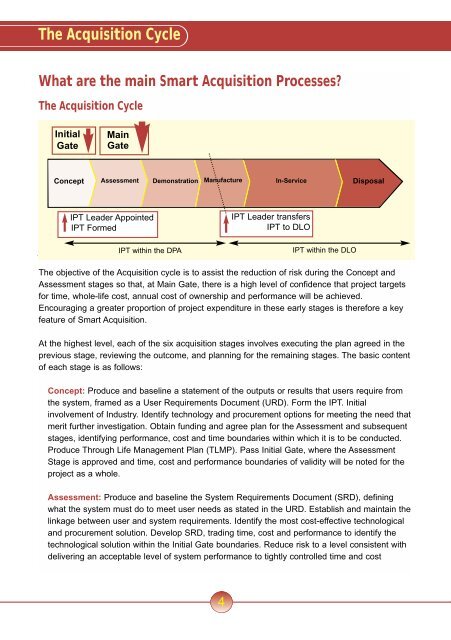The Acquisition Handbook
The Acquisition Handbook
The Acquisition Handbook
- No tags were found...
Create successful ePaper yourself
Turn your PDF publications into a flip-book with our unique Google optimized e-Paper software.
<strong>The</strong> <strong>Acquisition</strong> CycleWhat are the main Smart <strong>Acquisition</strong> Processes?<strong>The</strong> <strong>Acquisition</strong> CycleInitialGateMainGateConcept Assessment Demonstration ManufactureIn-Service DisposalIPT Leader AppointedIPT FormedIPT within the DPAIPT Leader transfersIPT to DLOIPT within the DLO<strong>The</strong> objective of the <strong>Acquisition</strong> cycle is to assist the reduction of risk during the Concept andAssessment stages so that, at Main Gate, there is a high level of confidence that project targetsfor time, whole-life cost, annual cost of ownership and performance will be achieved.Encouraging a greater proportion of project expenditure in these early stages is therefore a keyfeature of Smart <strong>Acquisition</strong>.At the highest level, each of the six acquisition stages involves executing the plan agreed in theprevious stage, reviewing the outcome, and planning for the remaining stages. <strong>The</strong> basic contentof each stage is as follows:Concept: Produce and baseline a statement of the outputs or results that users require fromthe system, framed as a User Requirements Document (URD). Form the IPT. Initialinvolvement of Industry. Identify technology and procurement options for meeting the need thatmerit further investigation. Obtain funding and agree plan for the Assessment and subsequentstages, identifying performance, cost and time boundaries within which it is to be conducted.Produce Through Life Management Plan (TLMP). Pass Initial Gate, where the AssessmentStage is approved and time, cost and performance boundaries of validity will be noted for theproject as a whole.Assessment: Produce and baseline the System Requirements Document (SRD), definingwhat the system must do to meet user needs as stated in the URD. Establish and maintain thelinkage between user and system requirements. Identify the most cost-effective technologicaland procurement solution. Develop SRD, trading time, cost and performance to identify thetechnological solution within the Initial Gate boundaries. Reduce risk to a level consistent withdelivering an acceptable level of system performance to tightly controlled time and cost4
















